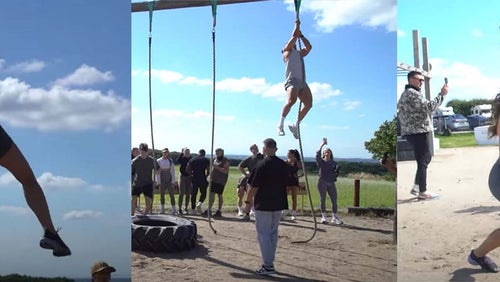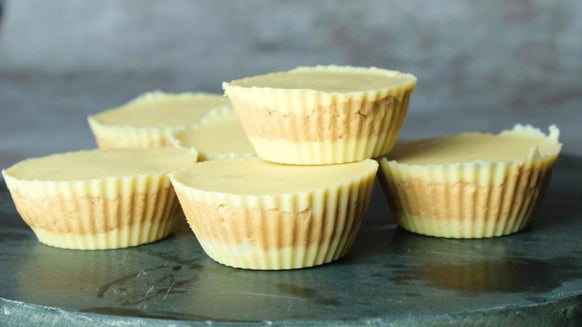
Ever heard of ‘The 200 Club’? If you haven’t you’re about to.
The idea of the 200 club is something that’s taken a lot of fitness apps by storm. The latest being an idea from a certain ‘God of Thunder’ actor, as part of a no-equipment- needed challenge.
Consisting of five bodyweight exercises that use the full body, the workout unsurprisingly requires participants go through a circuit of 200 reps per exercise.
These types of challenges pop up a lot across the fitness industry, but are they worth the hype and will you see the results? We’re breaking it down for you…
What is the 200 club?
Simply put, the 200 club is a bodyweight circuit that incorporates 5 exercises to hit the full body.
To complete the circuit, you hit 200 reps of each exercise before moving onto the next. So you complete 200 squats before moving onto 200 press ups and so on. The exercises are strictly bodyweight.
The current popularized circuit consists of mountain climbers, squats, press-ups, flutter kicks, and sit throughs. All these movements are challenging enough in high reps without the need of additional resistance.
The high rep range is a lot, and maintaining form throughout the entire rep range leads to the high difficulty for this type of training and trend.
The workout is high intensity and puts a lot of repeated stress on the same muscle group in order to complete the reps, leading to muscle fatigue.
Are there any benefits?
The 200 club has benefits and will challenge mind and body in a top-to-toe high intensity workout.
As with such training methods as metcons, hiit and short, sharp cardio workouts, this style of training can raise the heart rate quickly, leading to a greater level of calorie burn over a shorter period, and longer utilization of fat stores throughout the day.
So, for those looking to lower fat levels and drive cardiovascular endurance, you can use this workout as an addition to regular training with a lot of benefits.
Consistent overloading of a muscle group will lead to it adapting and building both size and strength for your body to cope with the physical demand - our bodies are amazing, aren’t they?
So, performing 200 reps of a movement repeatedly over an extended period will see you build strength and muscular endurance.
With workouts like these, bodyweight is more than enough resistance to create fatigue and force your body and muscles to adapt. It’s a great alternative for those who struggle with heavier, low-rep training styles, but who still want to push themselves.
Are there any negatives?
The high intensity level and overload on singular muscles and movements before being able to move on can lead to quick fatigue and drop in safe form when performing the movements.
When form suffers, the risk of injury can increase. These challenges can be fun and are a great way to shake things up, but consider the risks to protect yourself from injury.
Overloading of certain muscle groups is another risk. If these types of workouts are repeated too regularly, you can start to build imbalances in other areas of the body.
Working on 200 flutter kicks repeatedly will strengthen your rectus abdominis and obliques but could leave your posterior chain weakened, so it’s important to have well rounded training that delivers balance and a symmetrical frame.
It’s worth noting this workout falls outside of the traditional training pyramid, and proven ways of progressively overloading to work to your goal over a consistent period.
As mentioned, high rep workout formats can be a great way to break a plateau or mix things up in your training occasionally, but a structured plan over a minimum of a 12-week period with clear progressions and measurable milestones is needed for optimal results.
Who is this workout good for?
High intensity challenges, such as the 200 club, are great for people who have a good level of fitness - those who are training regularly but want to overcome boredom, or challenge their body to something new as part of regular training.
These challenges are a great way to really test yourself mentally and physically, and when combined alongside other movements they are a great way to keep the body guessing and help aid in your longer-term goals.
This workout is highly demanding and would require someone to have a good form and be competent in the movements required before hitting such high reps.
Injury risk increases with a high level of fatigue so if an individual is new to training or struggles with form in smaller rep sets then it is suggested to not attempt big set-based challenges such as this.
Other exercises that would give better results/be more effective
There are so many exercises and training styles within the fitness industry, and each has its own benefits and negatives.
Keep your end goal or reason for training in mind when adopting a trend-led workout. The 200 club is fun and very challenging in small doses, but nothing really beats a consistent program that pushes you to overload, adapt and grow without high risk of injury, and is tailored to your end goal.
Personalized programs trump trends by allowing you to build a well-rounded body without overloading muscle groups while neglecting others. Progressive programming styles have been result driven for years and are the most effective way to ensure you are continuing to build towards your goals.
200 club style challenges keep things fresh when incorporated into a training plan but aren’t a regular workout in themselves.
The current example sees some great anterior-focused movements but there could be additional posterior movements to compliment a well-rounded circuit. More dynamic movements can be used such as burpees or jumps to help those who want to work on speed and power, and even regressions of movements for those less competent with movement standards or just starting out.
Take Home Message
Challenges keep things fresh and fun. When we’re stuck for time, on holiday, or have limited equipment and just want to get a high intensity good burn, then trends like the 200 club have their place and will deliver some limited results.
These challenges can be fun, new, and exciting for those who are training regularly and want to mix things up, or even as a benchmark to see how you’re progressing, but nothing beats a structured, progressive program that’s tailored to you, your goals, and hitting every muscle.
If you’re considering taking on the 200-rep workout, make sure you are competent in the movements and ready for the intensity. If form starts to break, consider managing the workload into small rep groups. If you feel pain, stop - the risk of injury when under fatigue is heightened, don’t be undone by ego.
Want more like this?
READ THESE NEXT:

Hybrid Athlete Attempts Ultimate Fitness Test
This is no walk in the park....













